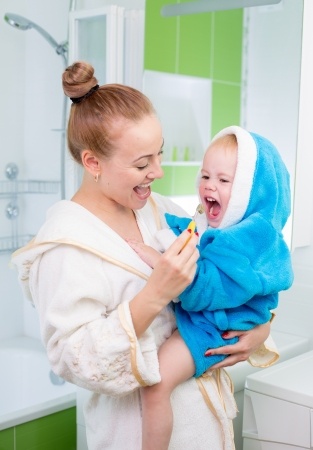12% Of 3 Year Olds Have Tooth Decay
By Dr Runa Mowla-Copley [caption id="attachment_639" align="alignright" width="313"] It's important to brush your child's teeth yourself until they are 8 years old.[/caption] For many parents (and indeed toddlers!) the tooth brushing routine elicits dread and tantrums. Some tots descend into complete meltdown at the mere mention of tooth brushing! Making the routine fun and interactive are key to turning the brushing experience into a relaxed affair. As young children are not able to clean their own teeth, parents must do it for them when they are very young and do it with them as they get older. A really good rule of thumb to go by is: when your child can write his own name, he is ready to brush on his own. A recent survey published by Public Health England found a staggering 12% of three year olds have tooth decay so setting good brushing habits early on in life can mean a lifetime of healthy happy teeth. Most children should be brushing their own teeth with parental supervision from eight years of age. By age 10, children should be able to brush their own teeth without the need for ongoing supervision. Brush teeth from when the first tooth appears (between the age of 6 months to 1 year). Even at this age teeth can get covered with plaque.
It's important to brush your child's teeth yourself until they are 8 years old.[/caption] For many parents (and indeed toddlers!) the tooth brushing routine elicits dread and tantrums. Some tots descend into complete meltdown at the mere mention of tooth brushing! Making the routine fun and interactive are key to turning the brushing experience into a relaxed affair. As young children are not able to clean their own teeth, parents must do it for them when they are very young and do it with them as they get older. A really good rule of thumb to go by is: when your child can write his own name, he is ready to brush on his own. A recent survey published by Public Health England found a staggering 12% of three year olds have tooth decay so setting good brushing habits early on in life can mean a lifetime of healthy happy teeth. Most children should be brushing their own teeth with parental supervision from eight years of age. By age 10, children should be able to brush their own teeth without the need for ongoing supervision. Brush teeth from when the first tooth appears (between the age of 6 months to 1 year). Even at this age teeth can get covered with plaque.
Useful tips to help clean your toddler’s teeth:
- Use a child-size toothbrush with soft bristles.
- Use a tiny dab of fluoride toothpaste - at age three, it should be the size of a pea.
- Choose a position where you can easily see your child’s mouth - for example, sit your toddler on your lap or stand behind your child with the head tilted back slightly.
- Brush twice a day - brushing before bed is especially important.
- Brush the tongue, the top of the tooth and both sides of the tooth; remember to brush where the teeth and gums meet, too.
- Brush for two minutes
- Spit out toothpaste after brushing but don't rinse. This way fluoride stays in the mouth, next to teeth where it can continue doing it's job.
- Gums that bleed need more brushing to make them healthy.
- Keep your toddler engaged in brushing. Use a timer, a short song, or counting as a game to encourage brushing for 2 minutes. There are many apps you can download with their own timer and games.
- If you’re using an electric toothbrush, avoid moving the brush in circles. Keep your hand still, and guide the brush across your child’s teeth and gums.
- Take your child to the dentist regularly when they reach one year of age.
[caption id="attachment_538" align="alignleft" width="150"] Dr. Runa M Copley[/caption]
Dr. Runa M Copley[/caption]
Dr Runa Mowla-Copley, BDS (Hons), DipOrth, runs Thumb Sucking clinics at Quadrant Orthodontics, Richmond & Knightsbridge Orthodontics. Runa is a highly experienced clinician with a special interest in orthodontics and facial development in teenagers and young children. She is based at Knightsbridge Orthodontics in London. Runa has worked at a number of prestigious orthodontic practices in Central London including an award-winning clinic in the West End. In 2010 she co-founded one of London’s first Thumb Sucking clinics. She is author of the successful illustrated children’s fiction book ‘Charlie’s Thumb’ - the perfect book for any child who has a thumb-sucking habit that you want to break. Charlie's Thumb: Charlie loves sucking his thumb all day and all night. A visit from the Tooth Fairy leads to some rather unusual events which make Charlie think perhaps sucking his thumb isn't such a good idea after all. Charlie’s Thumb is available online from Waterstones and Amazon.
